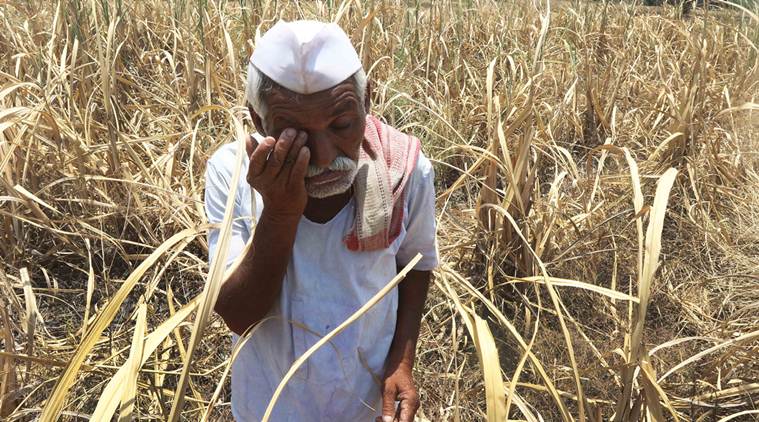- India
- International
Eye on polls, Uttar Pradesh makes mills in east crush cane though season long gone
While Uttar Pradesh’s sugar belt has post-Independence shifted to the western and central districts, sugar cane still retains political relevance in the four northeastern constituencies that vote in the last phase of polls on May 19.
 UP mills have made payments of Rs 20,739 crore to growers in the 2018-19 season as on Friday. This is just over 65% of the corresponding SAP value of Rs 31,689 crore. (Express Photo: Pradip Das)
UP mills have made payments of Rs 20,739 crore to growers in the 2018-19 season as on Friday. This is just over 65% of the corresponding SAP value of Rs 31,689 crore. (Express Photo: Pradip Das)
It is past mid-May, but the sugar mills at Hata, Ramkola, Kaptanganj, Khadda and Siswa Bazar — the first four in Kushinagar and the last in Maharajganj constituency — are still crushing cane that’s dry or even gone stale from the searing summer heat.
“In 2017-18 (the sugar year is from October to September), we operated until April 17. This year, we are yet to shut even after crushing 119.5 lakh quintals (lq), as against 91.54 lq and 59.23 lq in 2017-18 and 2016-17, respectively,” says Karan Singh, executive president of the KK Birla Group’s Avadh Sugar & Energy Ltd that owns the Hata mill.
What he does not state, however, is the reason for mills continuing to crush at this time, when moisture loss in the cane affects juice purity and reduces sugar recovery to hardly 10 per cent. The Hata factory’s average sugar-to-cane recovery has been 12 per cent-plus for the current season.
“They (the BJP-led government) want to ensure that crushing goes on until the last stick of cane remains in farmers’ fields. So, we will have to run at least until the (Lok Sabha) election is over,” says another Kushinagar miller, requesting anonymity.
Undivided Gorakhpur – which included Deoria, Kushinagar and Maharajganj — was once India’s sugar capital. In 1936, it had 23 mills, the highest for any district. That number is today down to eight: five in Kushinagar and one each in Deoria (Pratappur, the country’s first ever mill established in 1903), Maharajganj (Siswa Bazar) and Gorakhpur (Pipraich).
While Uttar Pradesh’s sugar belt has post-Independence shifted to the western and central districts, sugar cane still retains political relevance in the four northeastern constituencies that vote in the last phase of polls on May 19.

One indicator is the Pipraich mill, closed for two decades and recently revived. The new factory was opened by Prime Minister Narendra Modi on February 24, with about 3 lq of cane crushed on a trial basis this season.
Another mill at Gadaura in Maharajganj – belonging to JHV Sugar and with huge pending cane dues to farmers – did not crush at all. But the Yogi Adityanath government has forced even the cane of its growers to be diverted to other mills.
The five mills in Kushinagar alone have together crushed roughly 377 lq of cane in the current season — worth Rs 1,225 crore at the UP government’s state advised price (SAP) of Rs 325/quintal — compared to 343.87 lq in 2017-18 and 241.54 lq in 2016-17.
But not all farmers are impressed by the resolve to crush all cane offered to mills.
“Not only mills, even we lose by supplying dry cane that has lower weight. The 375-400 quintals/acre yield in January-February becomes 275-300 quintals now with less water content. One way to keep the cane fresh is by irrigation. But there’s no water in the canals now and irrigating by diesel pump-sets costs Rs 200 per hour. Also, you need nine hours to cover an acre in May, whereas it is only six in January-February,” says Baidyanath Singh, who cultivates cane on eight of his 12-acre holding at Karmaha Ugersen village in Hata tehsil.
Prabhunath Mishra, a seven-acre farmer from Bharwalia village in the same tehsil, blames the Yogi Adityanath government for not issuing on time parchis or indents against which farmers supply cane to mills.
“Until last year, factories issued the parchis. They would do farmer-wise, field-wise and variety-wise surveys in May-June and prepare a supply calendar for the next season. Every farmer, depending on how much of his area was under early-maturing or regular ratoon and early or normal plant-cane varieties, would be given parchis for supply throughout the season. The parchis (each representing a tractor trolley-load of 30, 45 or 60 quintals) came once in 15 days or so and the farmer would deliver the cane within 72 hours,” he says.
But from 2018-19, a new system of parchis, issued by cane cooperative societies, has been introduced. “The societies are incapable of conducting proper surveys. They have subcontracted the job to private vendors, who do the calendaring using some software based on the so-called field inputs from the societies. All we know is that we haven’t received the parchis on time and that’s the real reason for such an extended crushing season. Does the government have any idea of what it takes for a farmer to crush cane and bring to mills at 45 degrees Celsius?” says Mishra.
“They have totally messed up. Farmers have been running helter-skelter for parchis and there is no redress mechanism, as everything is supposed to be software-based and even mills are helpless,” alleges R P N Singh, the Congress candidate from Kushinagar.
His great-grandfather Jagdish Pratap Narayan Singh, the erstwhile Maharaja of Padrauna, was among Gorakhpur’s early sugar entrepreneurs. His family set up the mills at Padrauna, Kathkuiyan and Khadda, besides inviting the Khetans of Calcutta to put up plants at Ramkola and Chhitauni – all in Kushinagar. “Most of these, and even the Saraya factory in Gorakhpur (promoted by the Majithias of Punjab), are shut. In the 2014 elections, Modi had promised re-opening of the Padrauna mill within 100 days. What has happened to that?” he says.
Mishra, however, maintains that “ganne ki baat alag hai, is baar ka mudda rashtra suraksha hai (cane is a separate issue; this election is on national security)”. His vote, he adds, is for “Modiji”. It’s not clear how many of his fellow-farmers are inclined to make this distinction.
Meanwhile, according to the Cane Commissioner’s Office at Lucknow, UP mills have made payments of Rs 20,739 crore to growers in the 2018-19 season as on Friday. This is just over 65% of the corresponding SAP value of Rs 31,689 crore. The ratio is better, at 85-92% for mills such as Hata and Ramkola.
Apr 19: Latest News
- 01
- 02
- 03
- 04
- 05






































